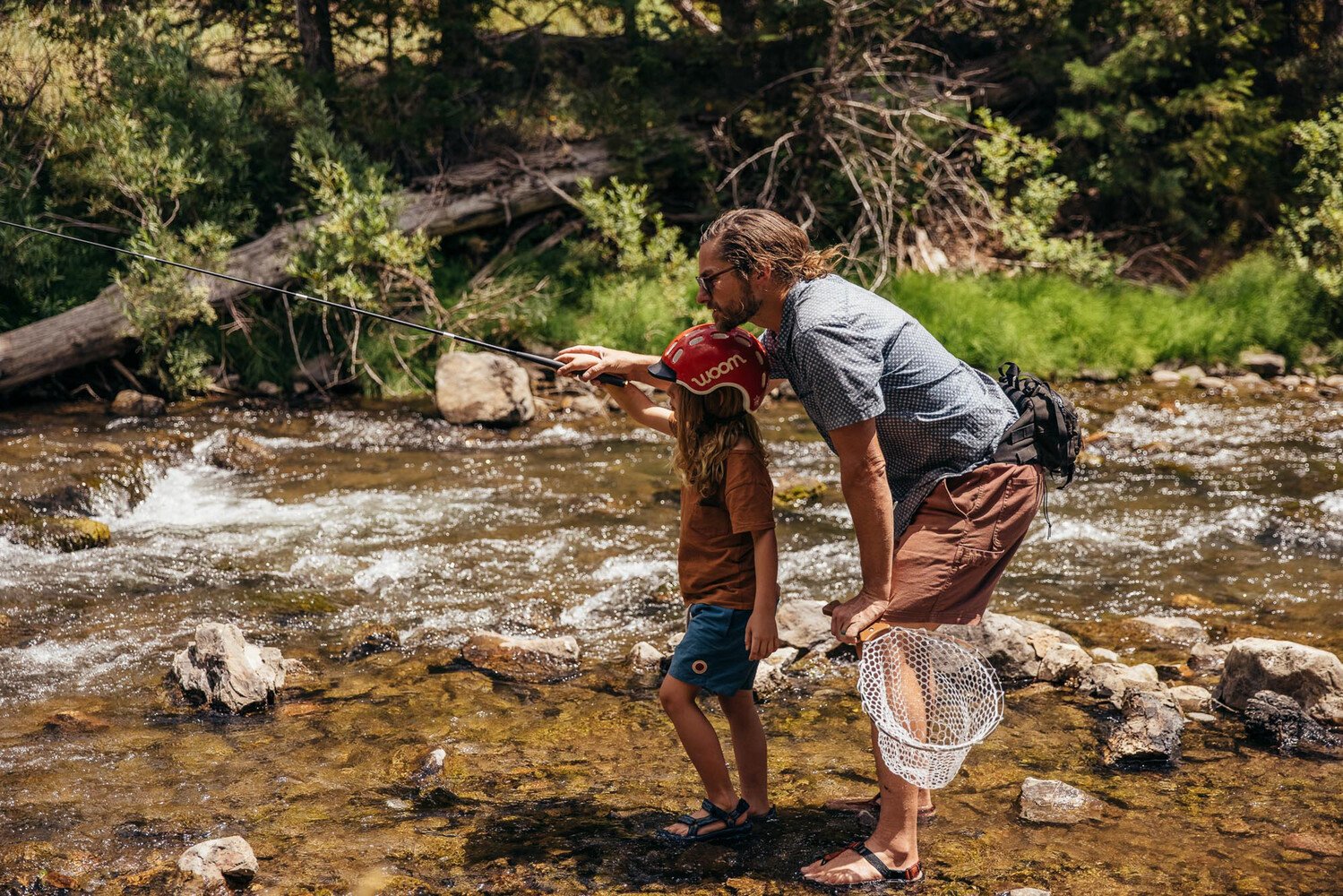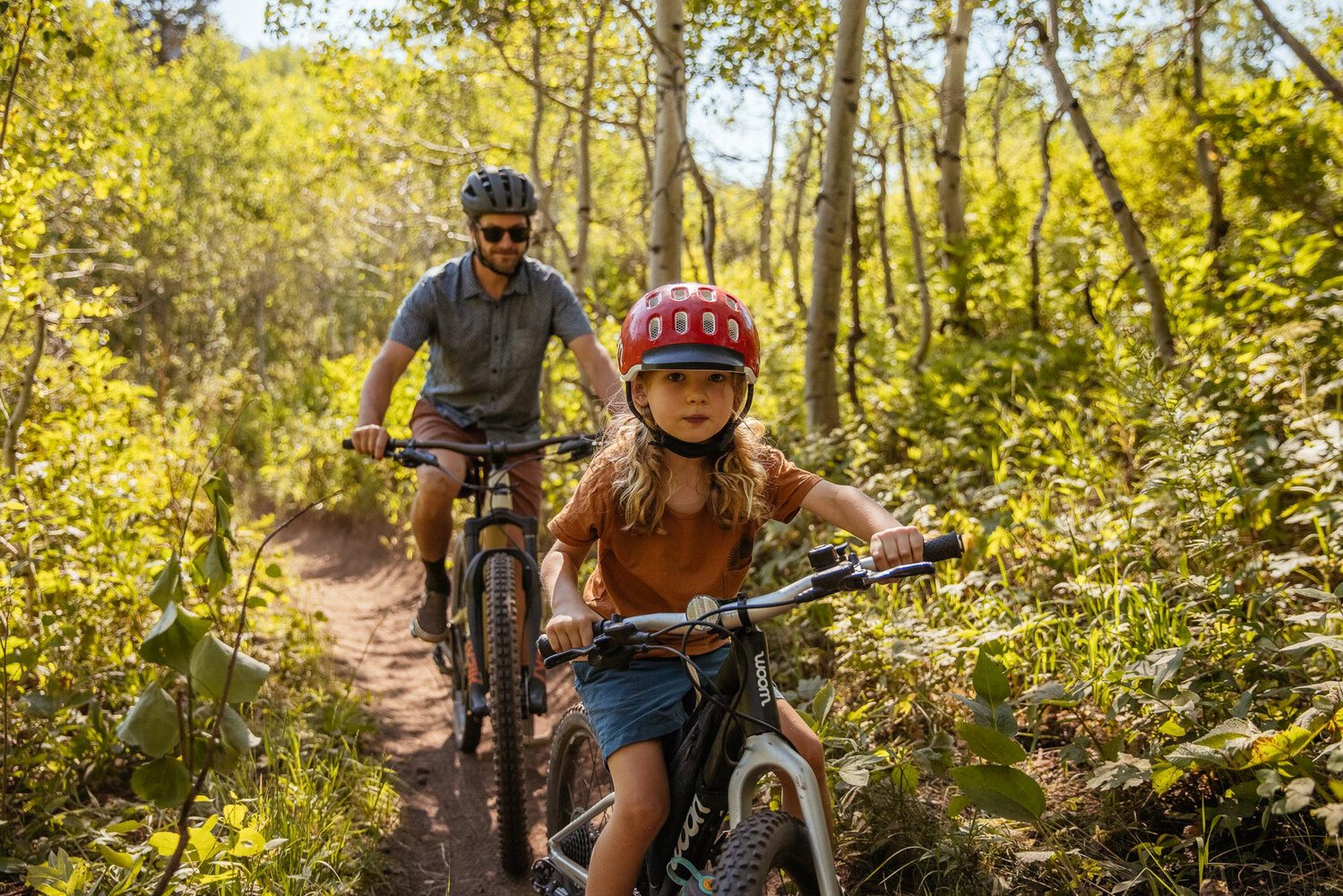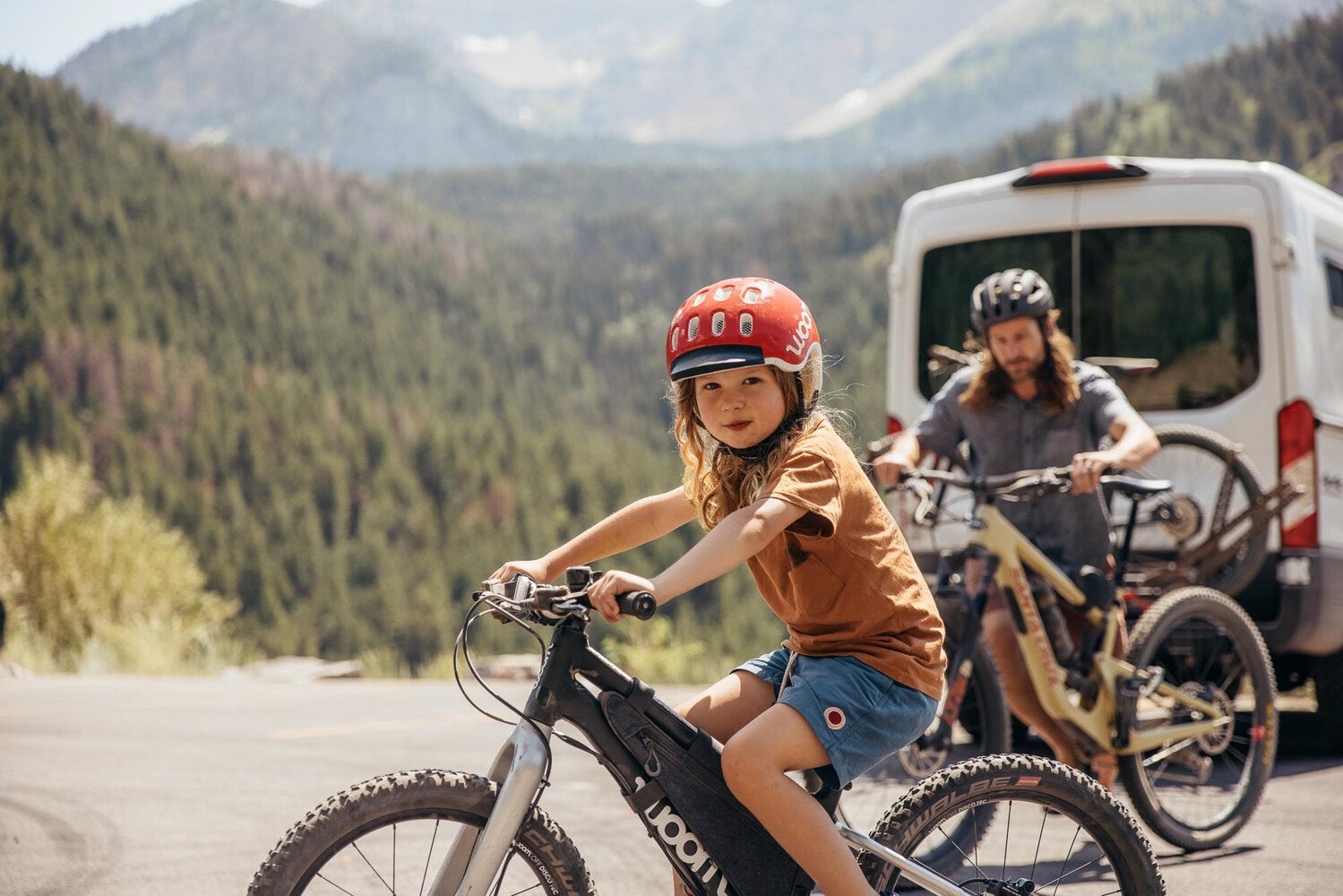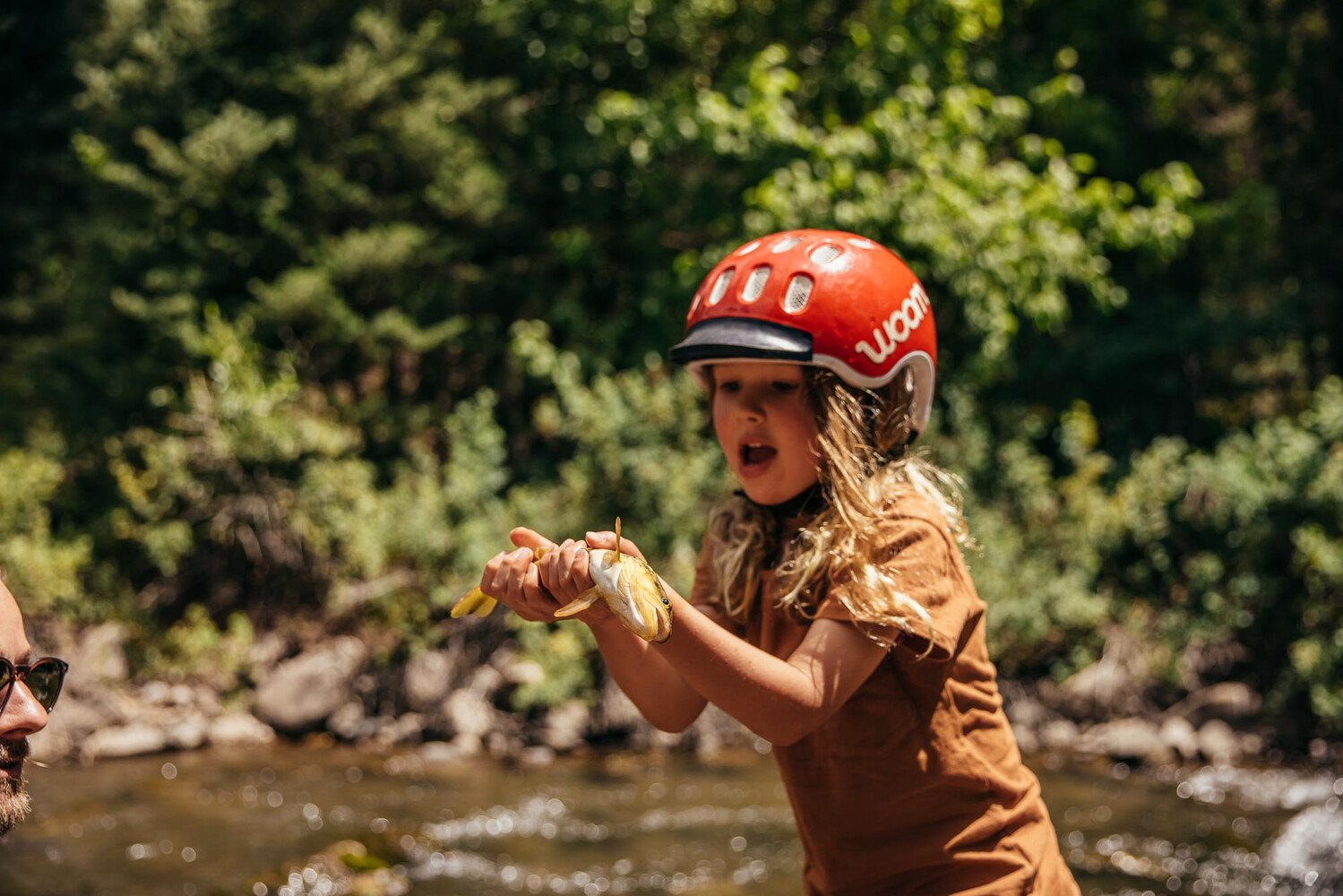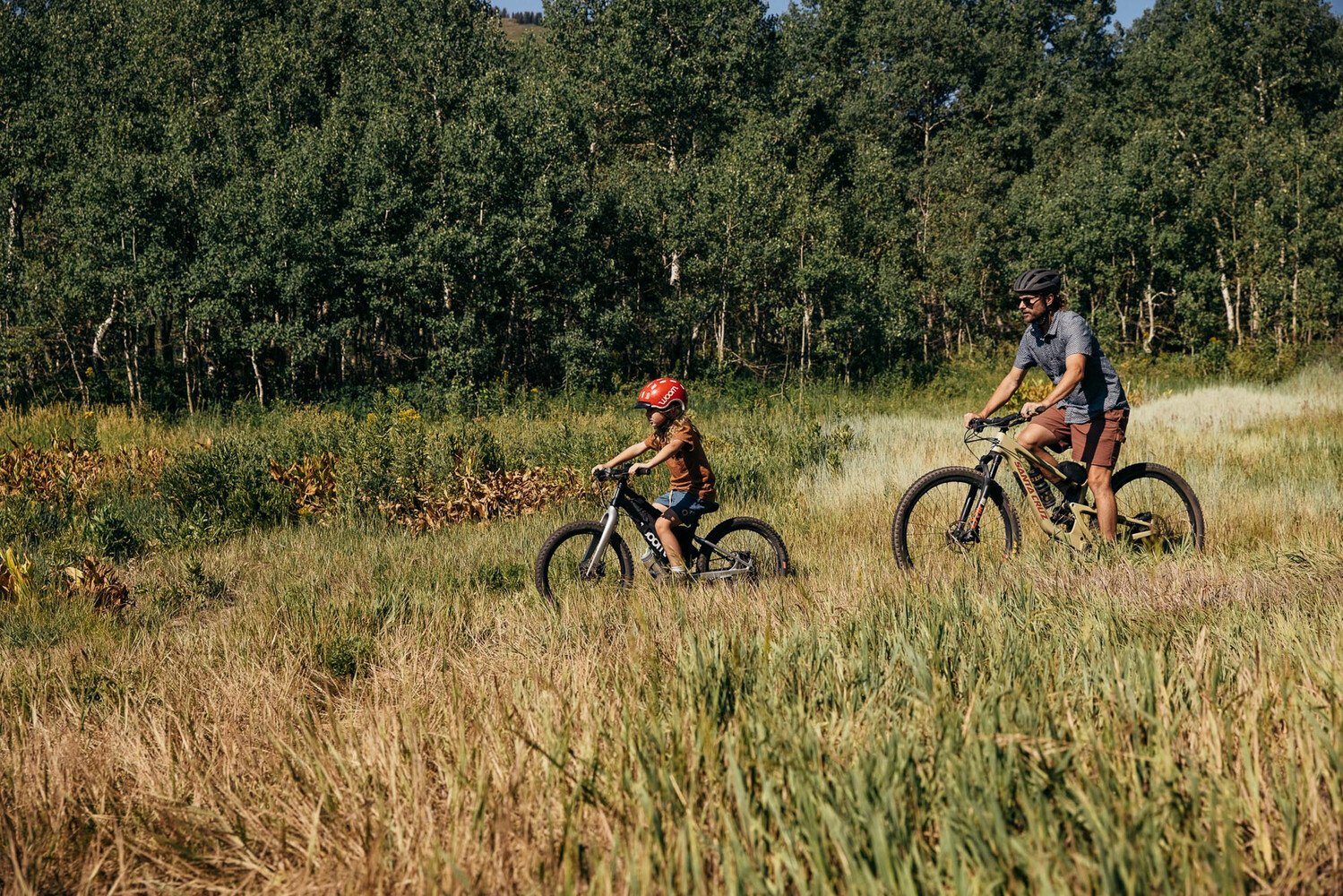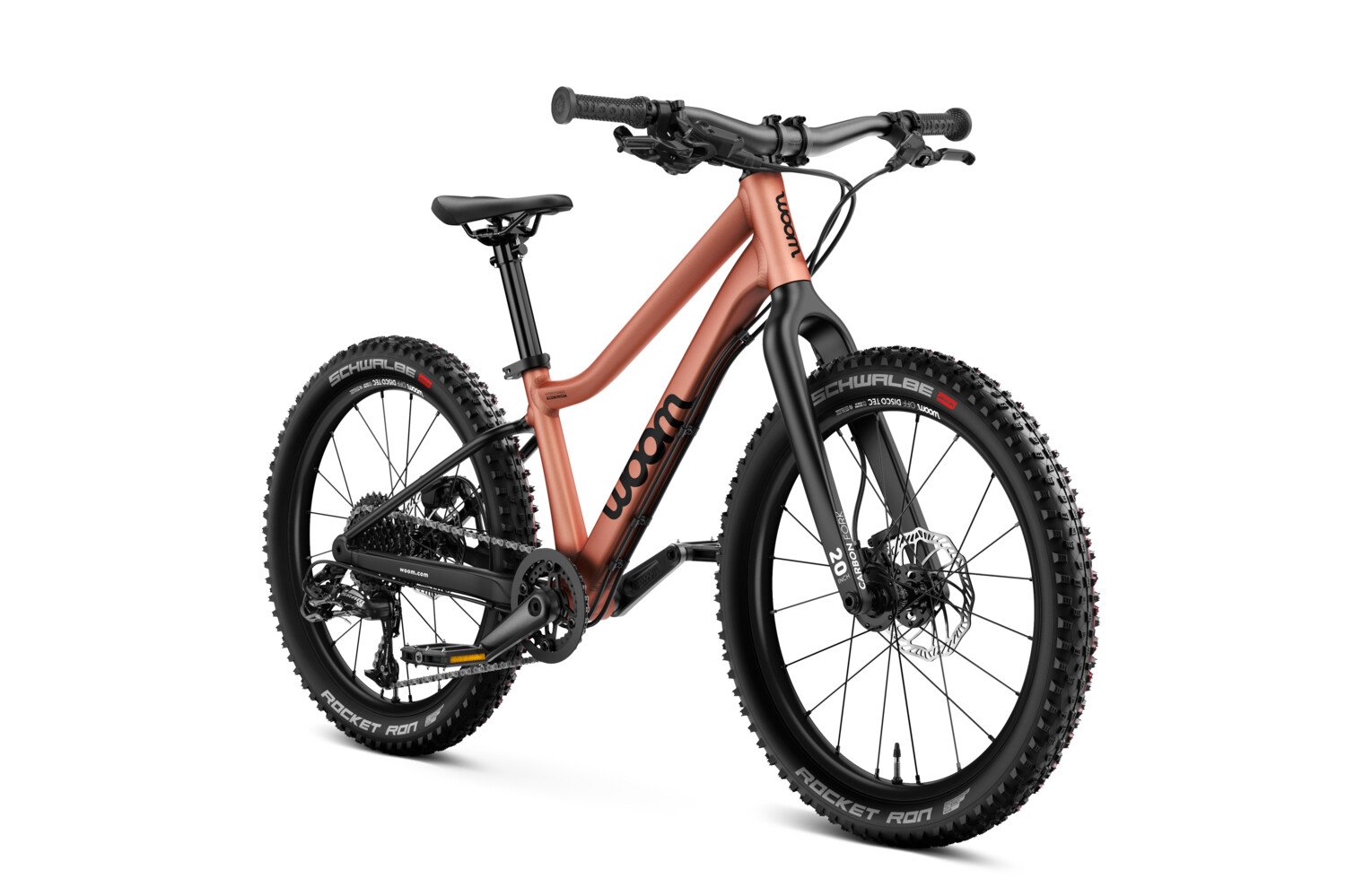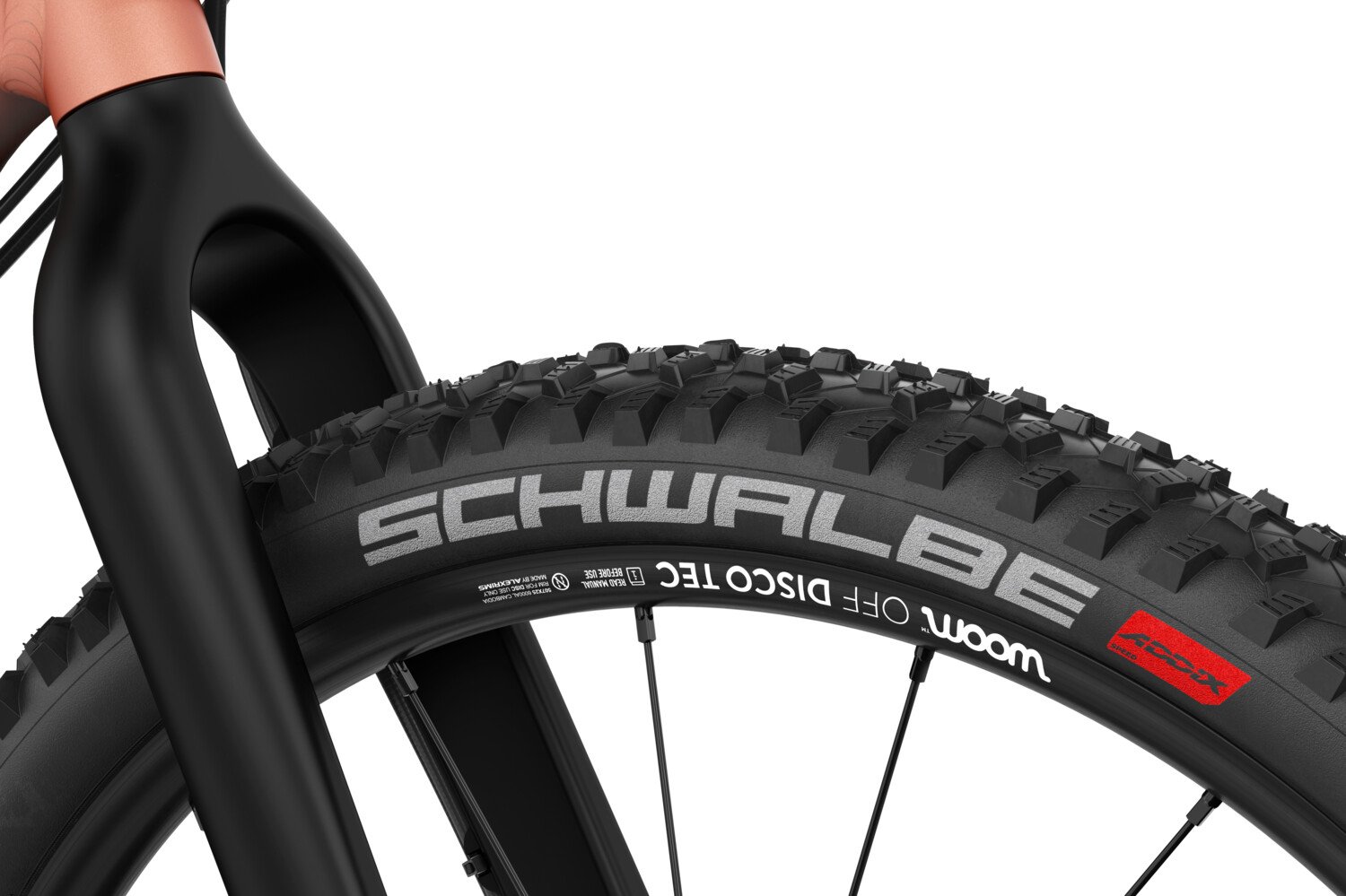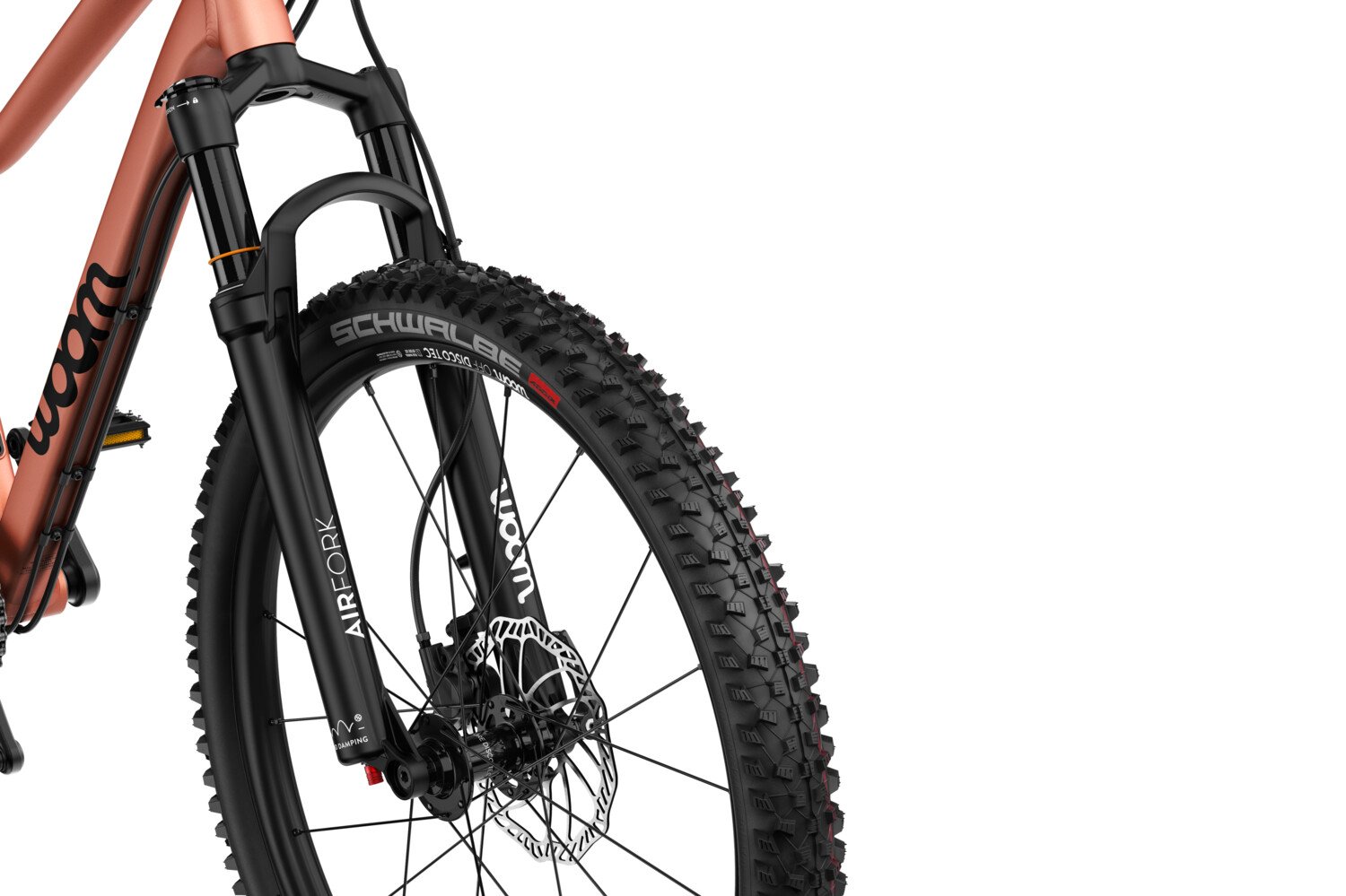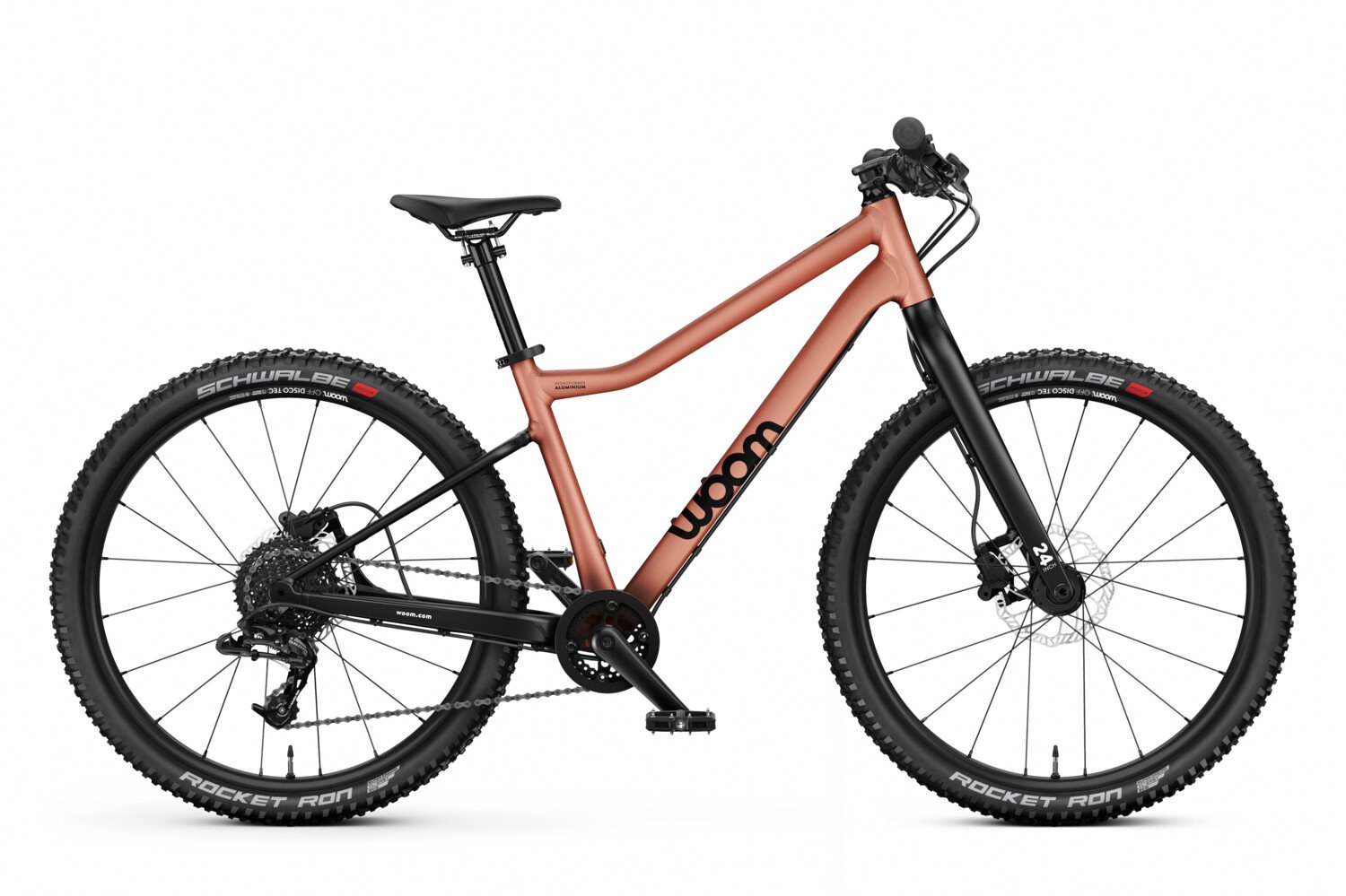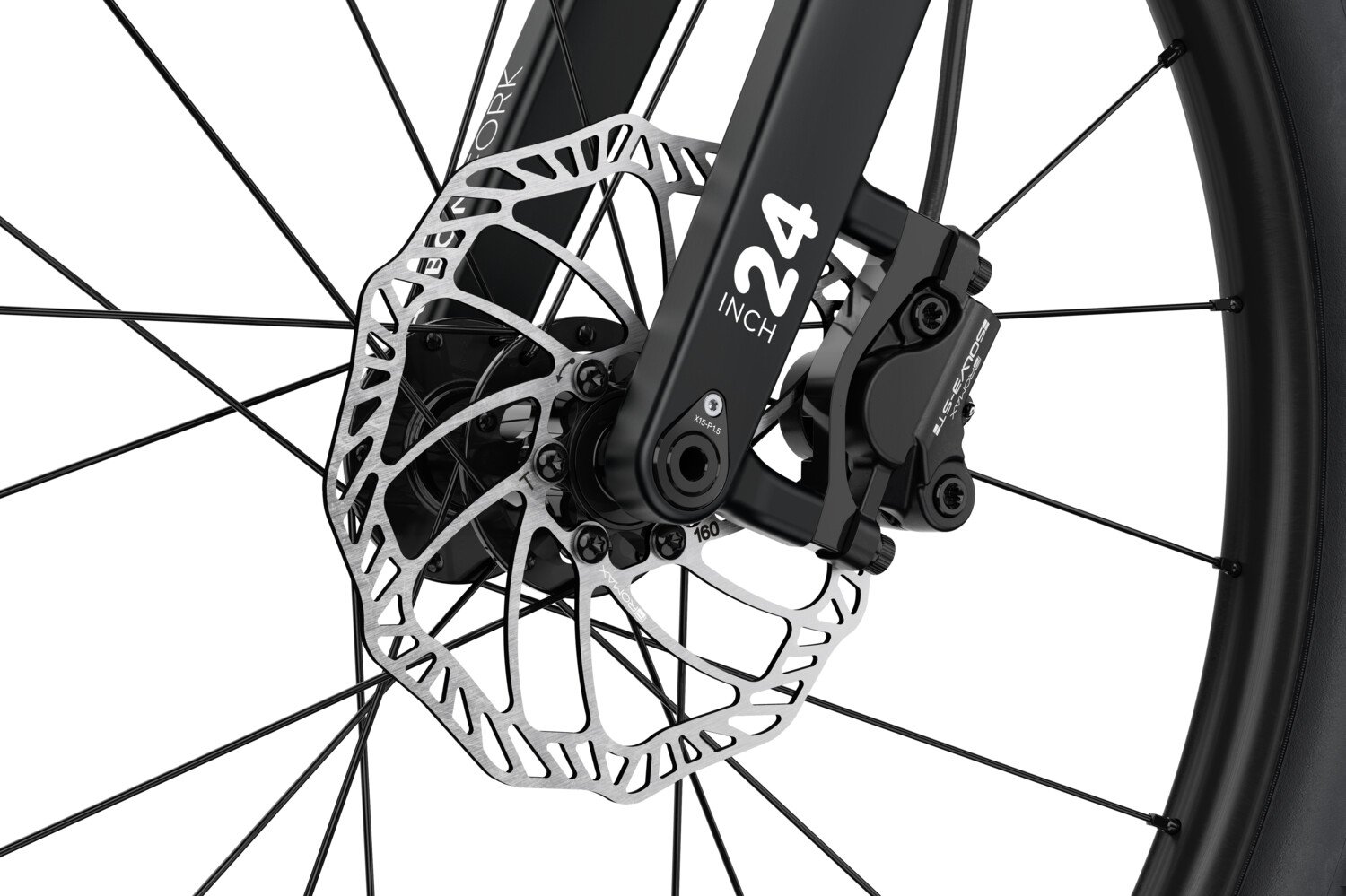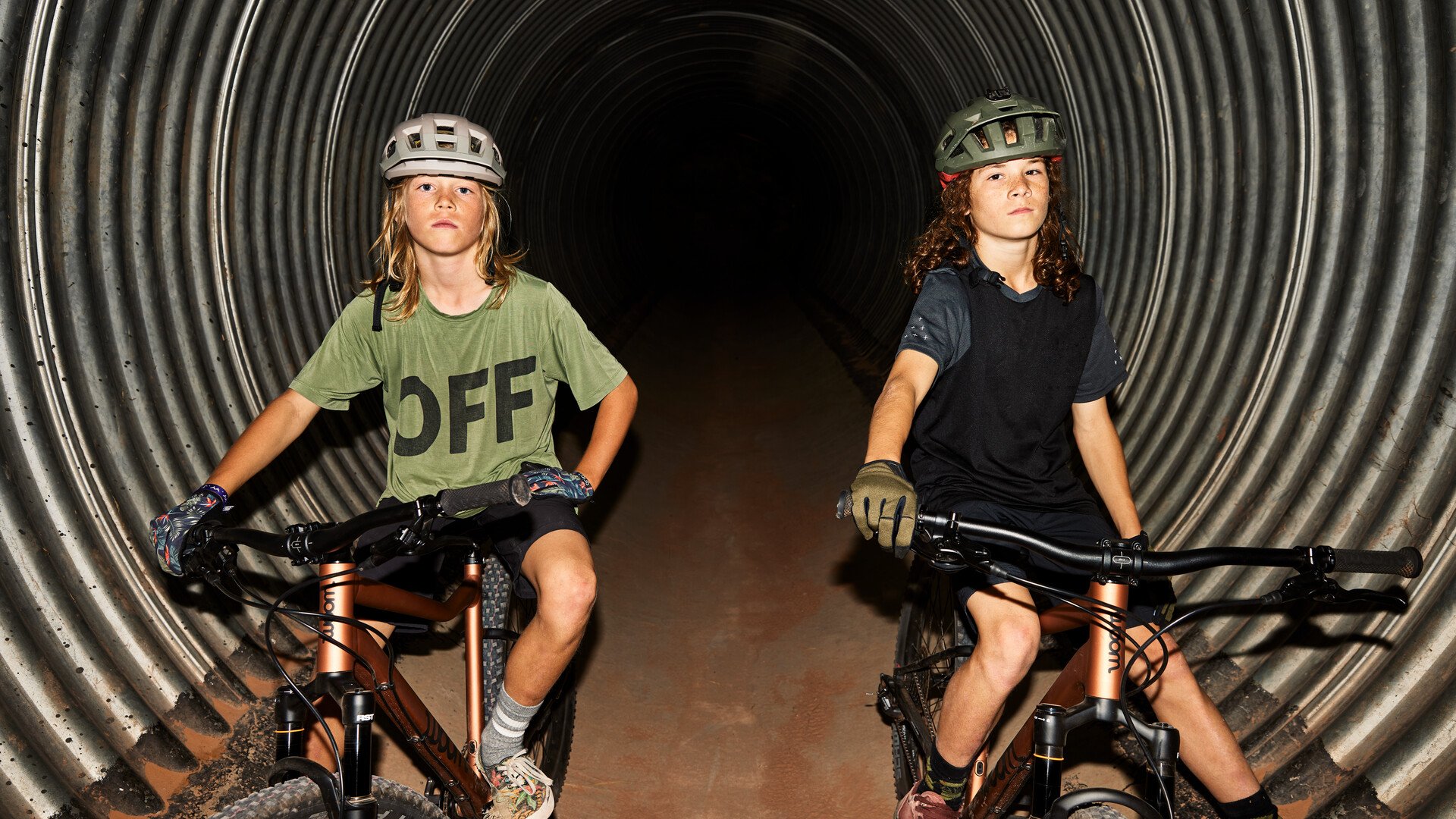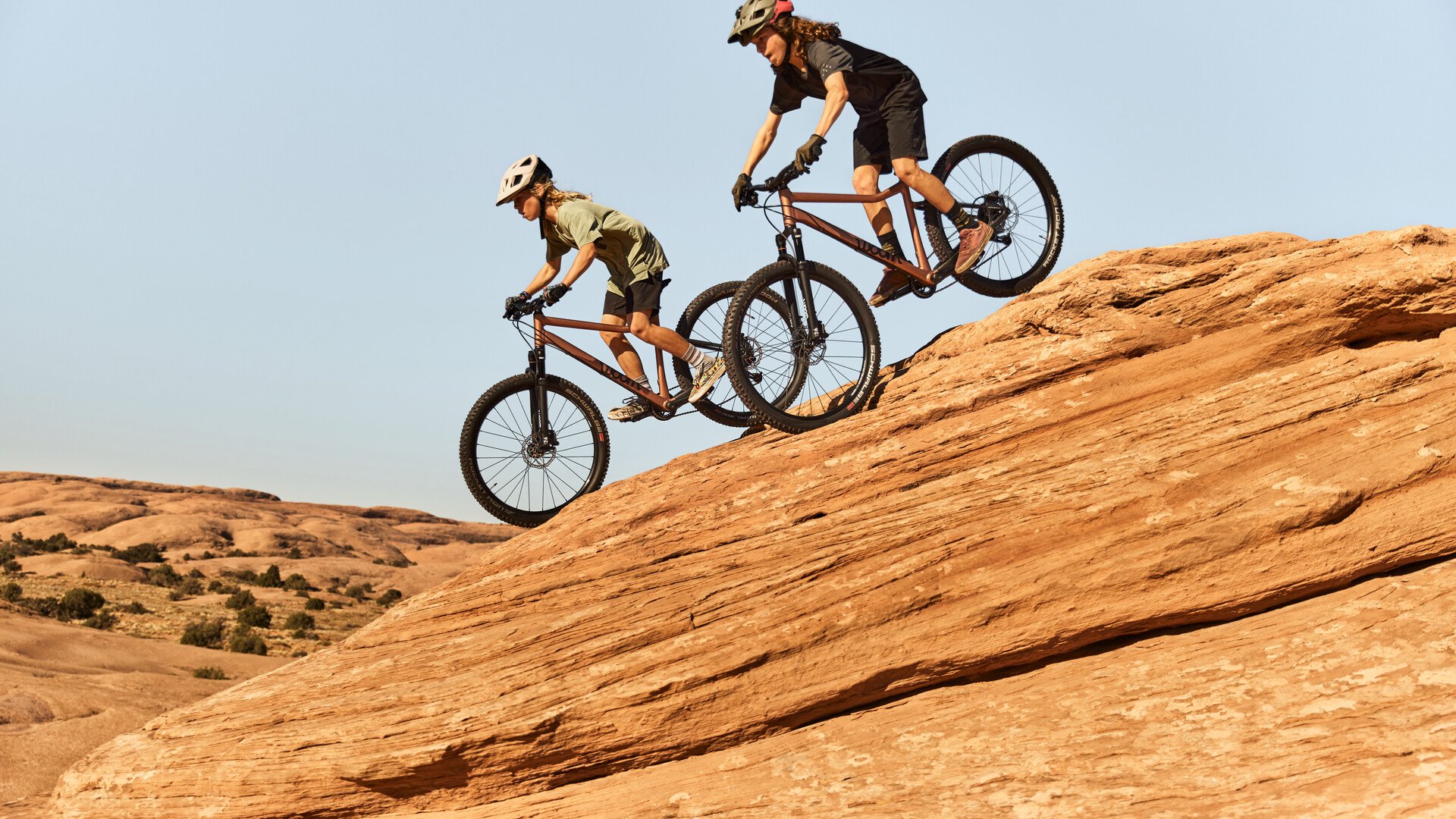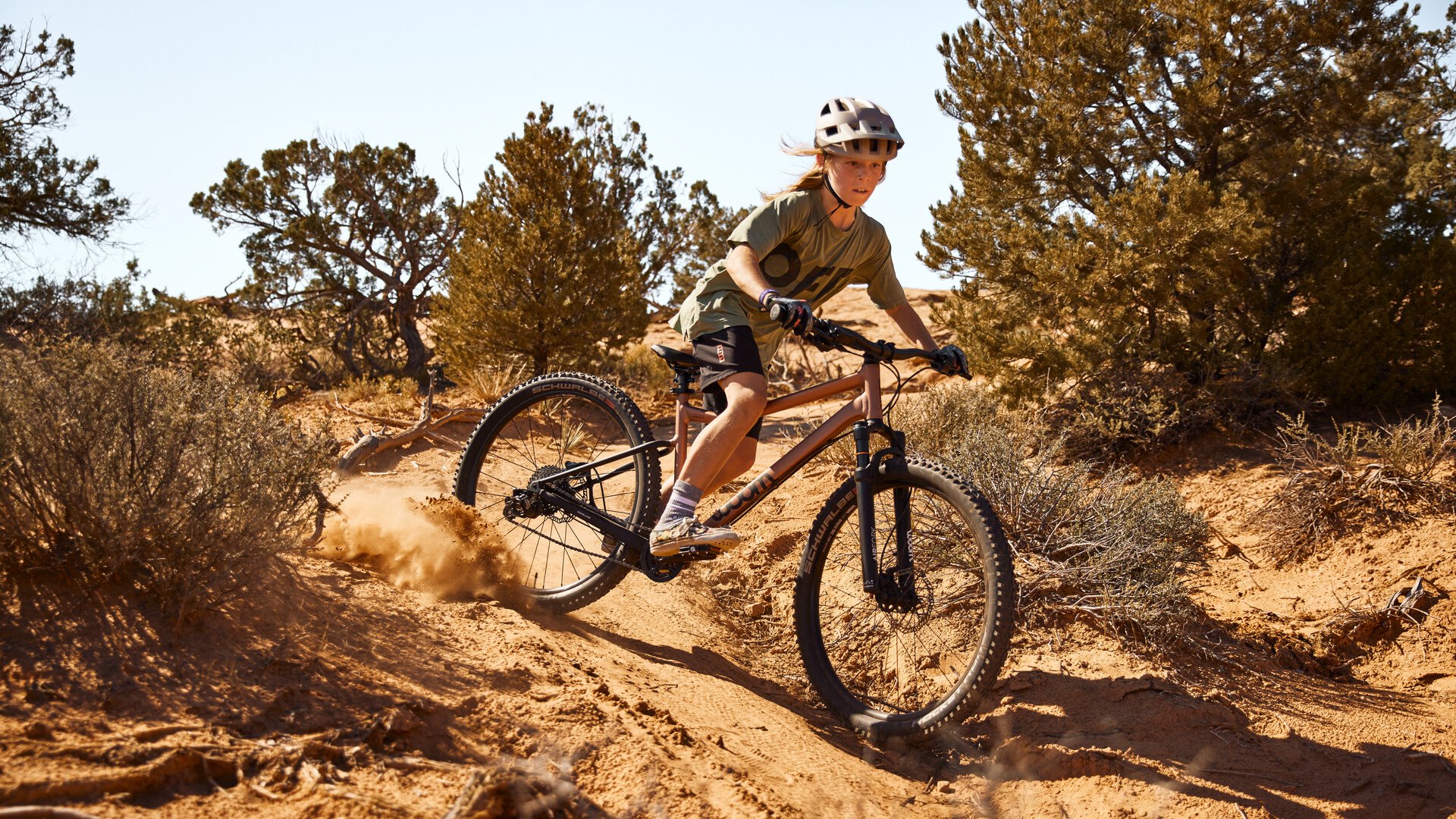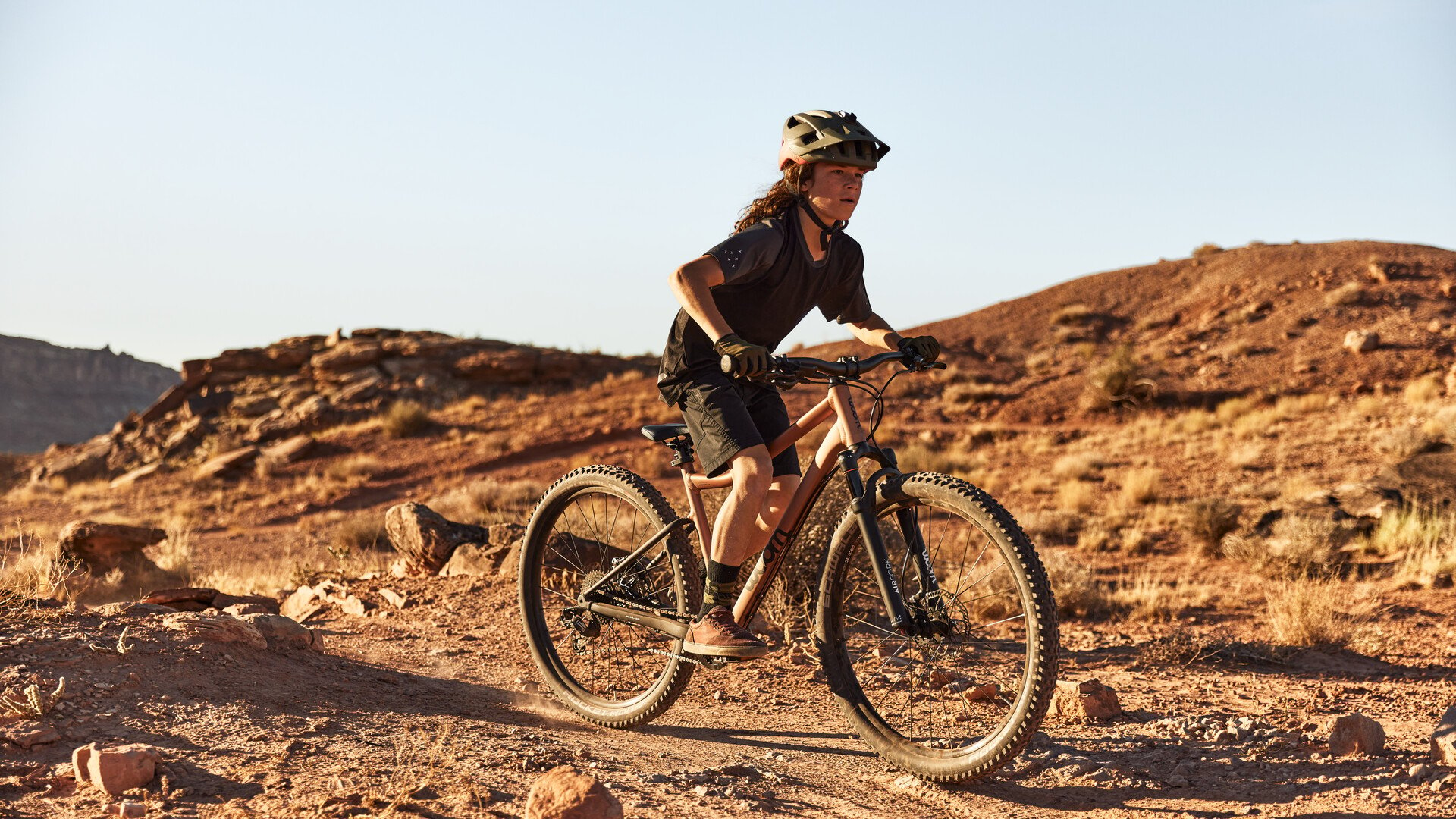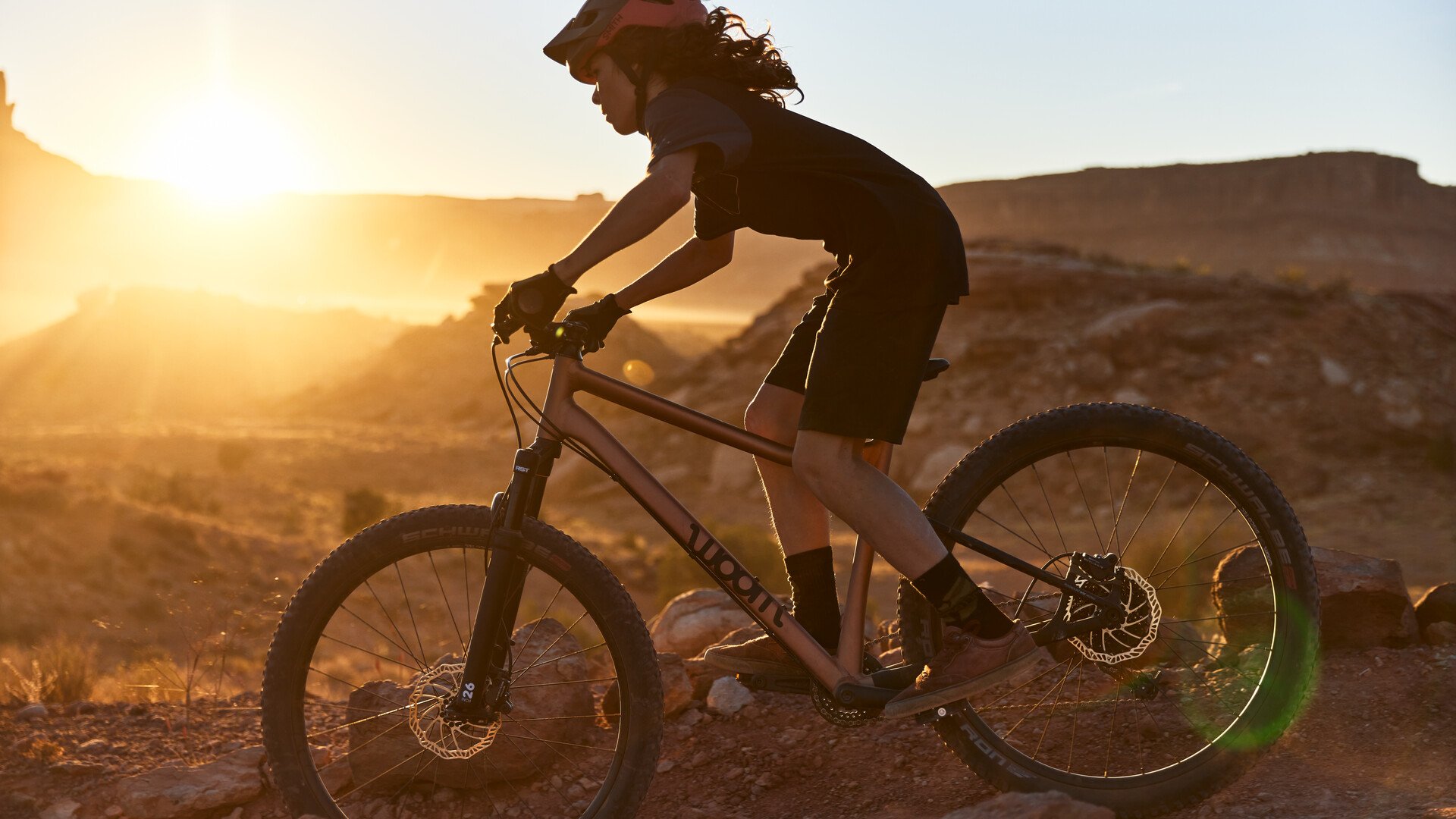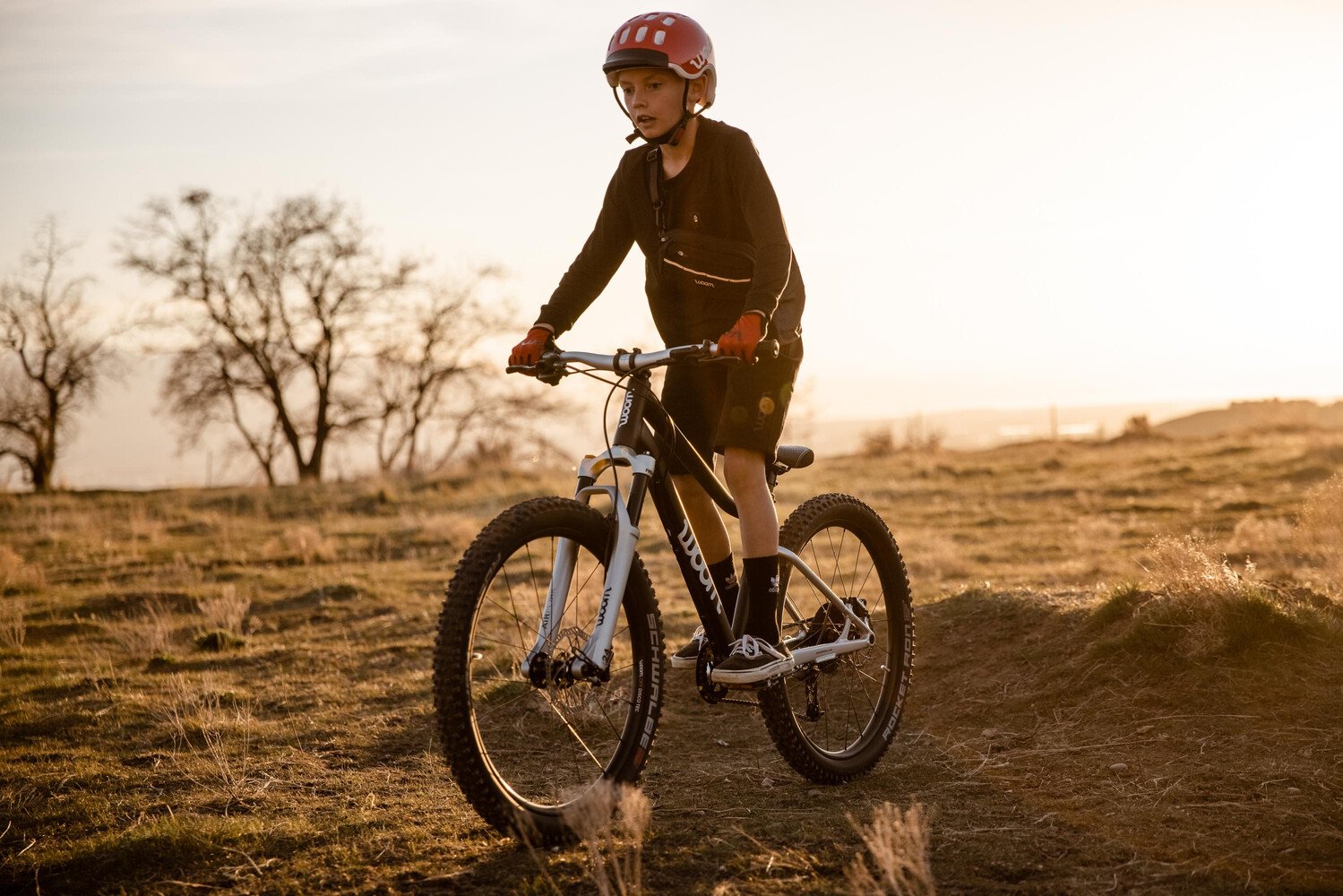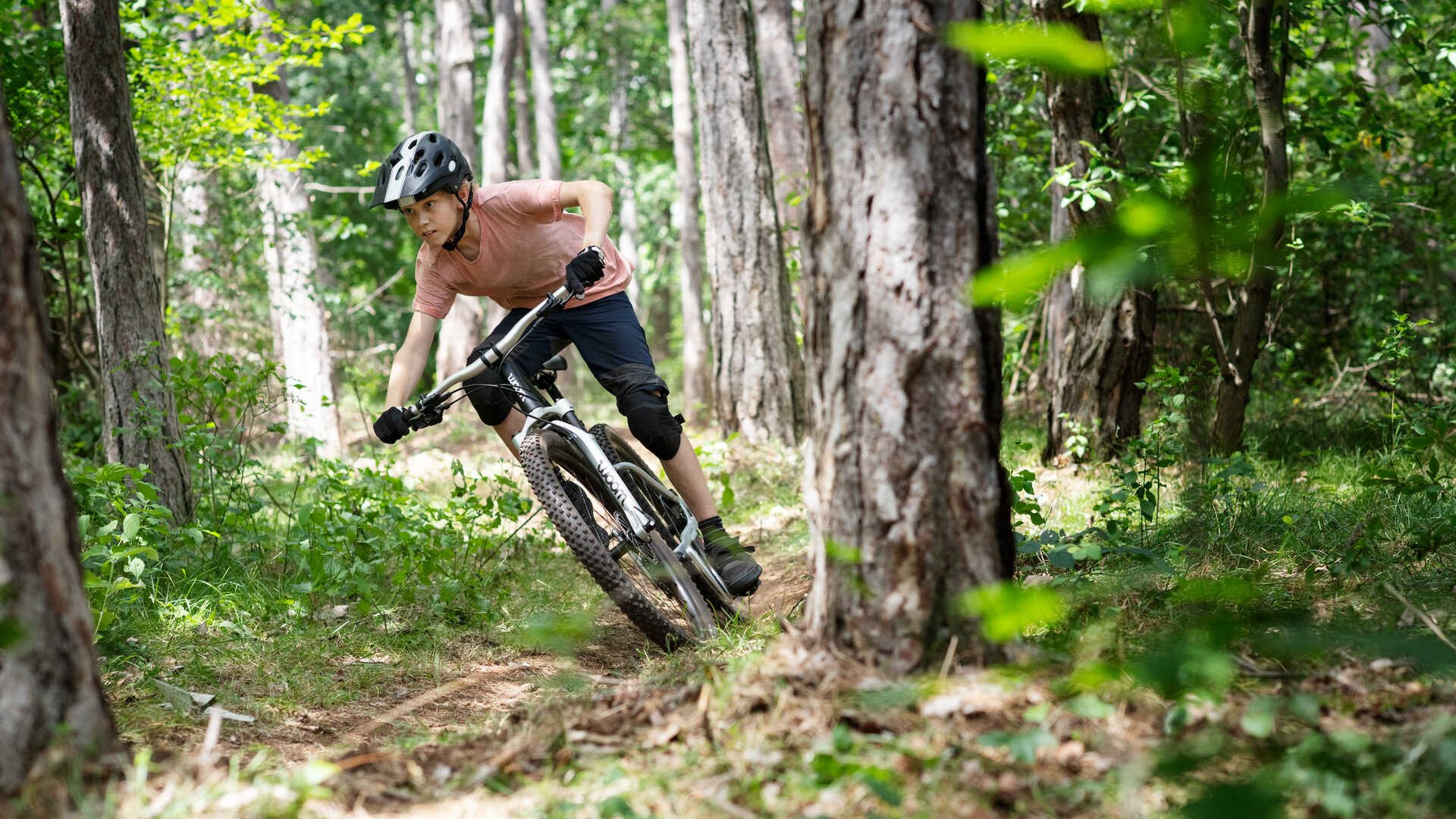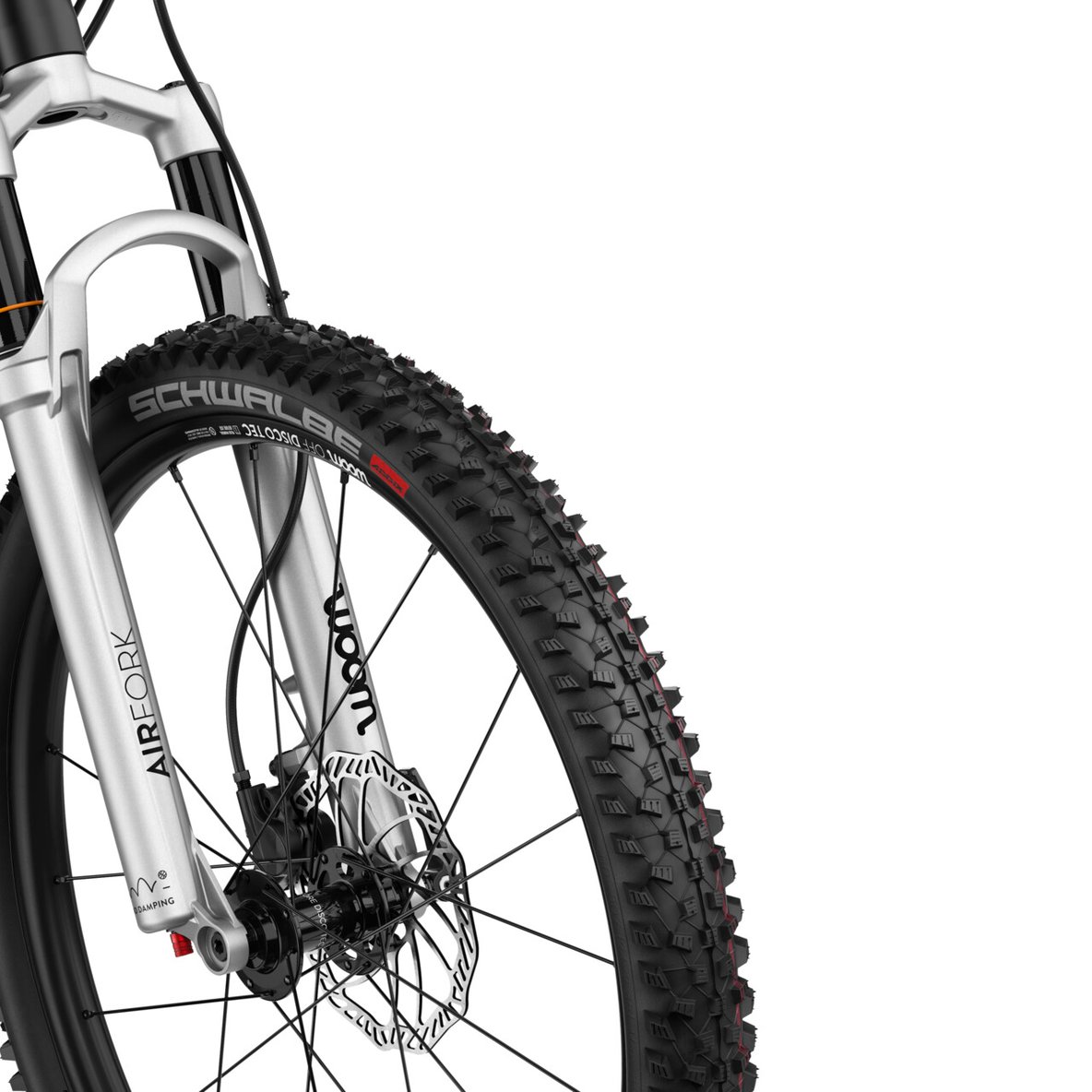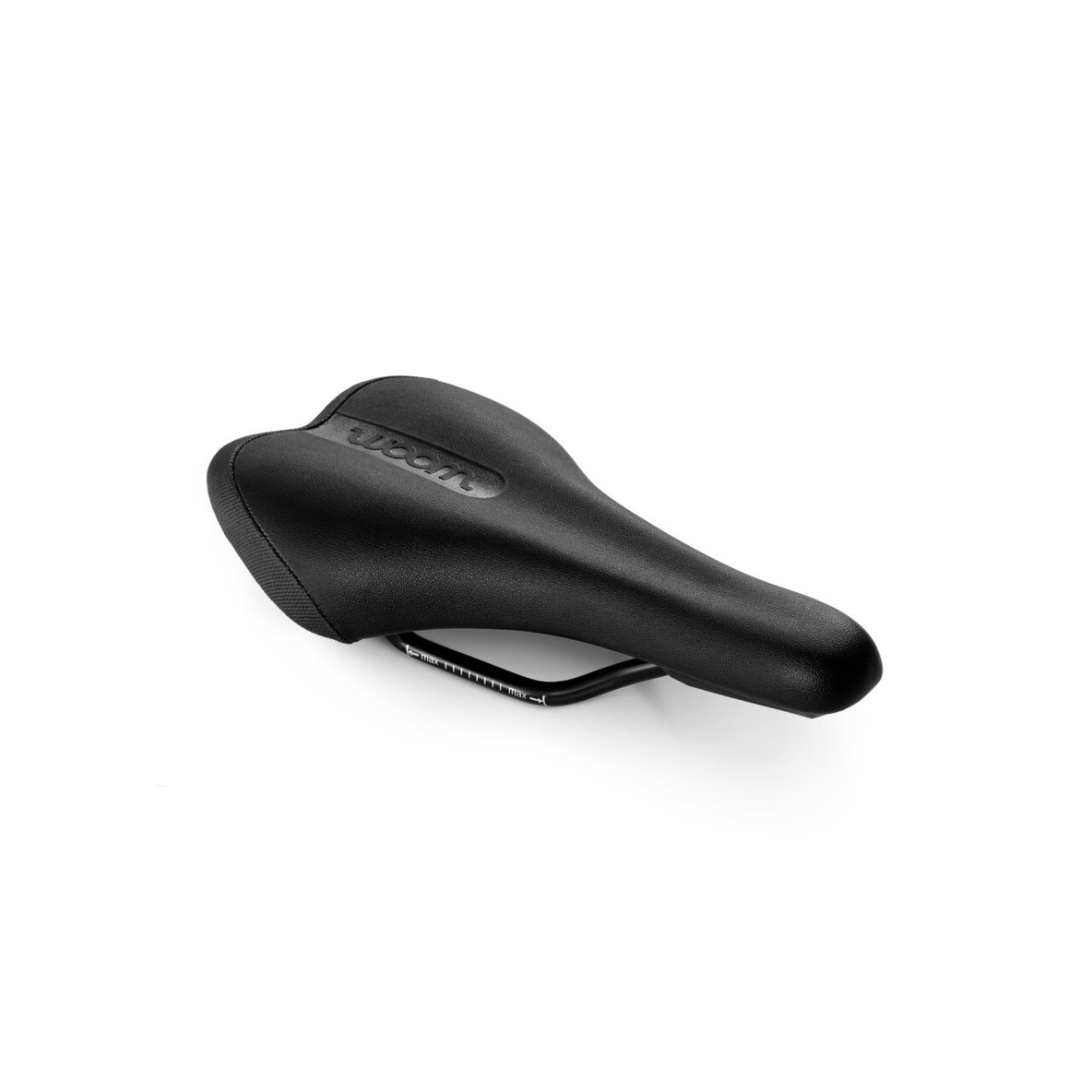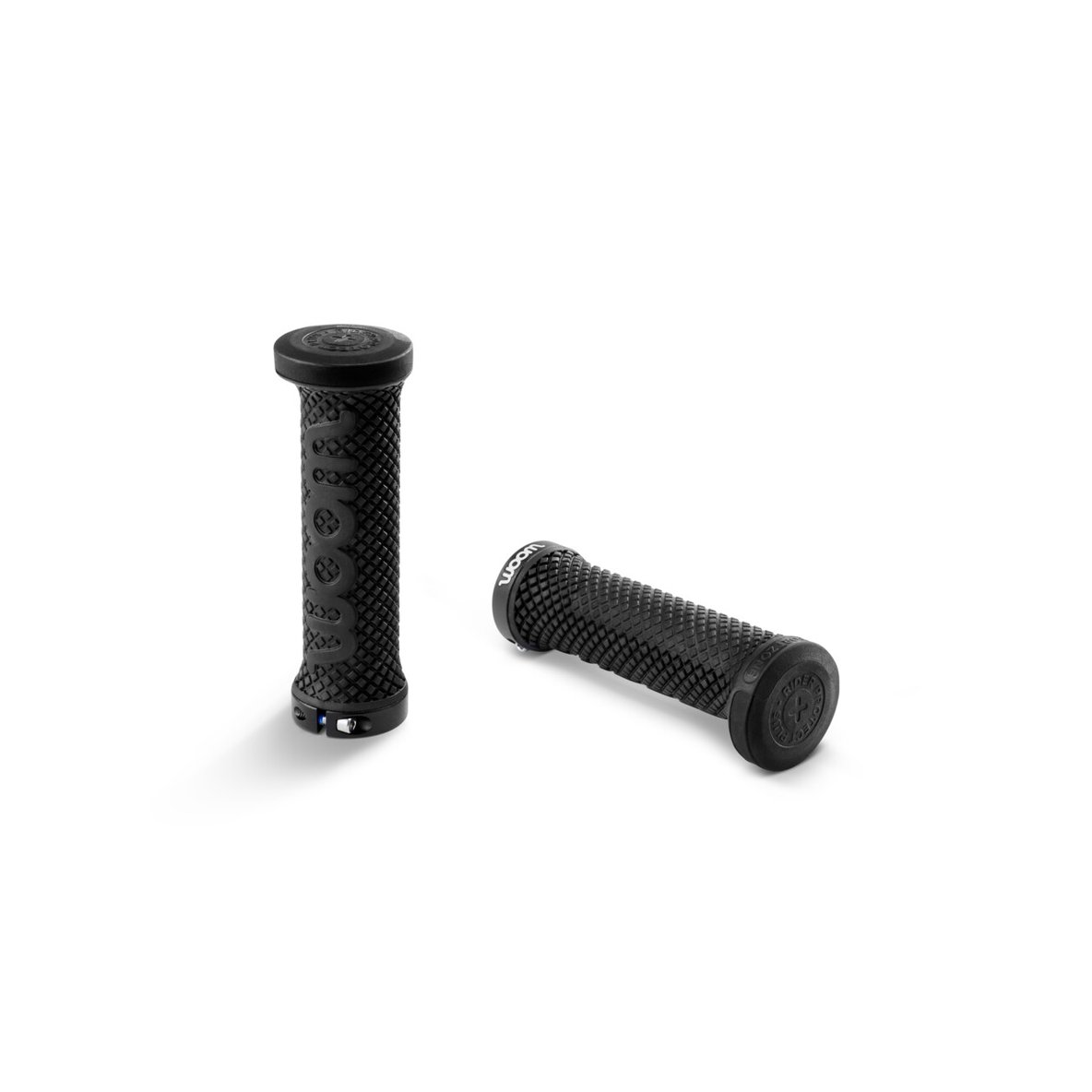Bringing up a life-long shredder – everything you need to know about motivation, route planning, equipment, and technique
Keep reading to discover our tried-and-tested ways to ignite your child's passion and find out everything else worth knowing about taking your child on a mountain bike adventure.

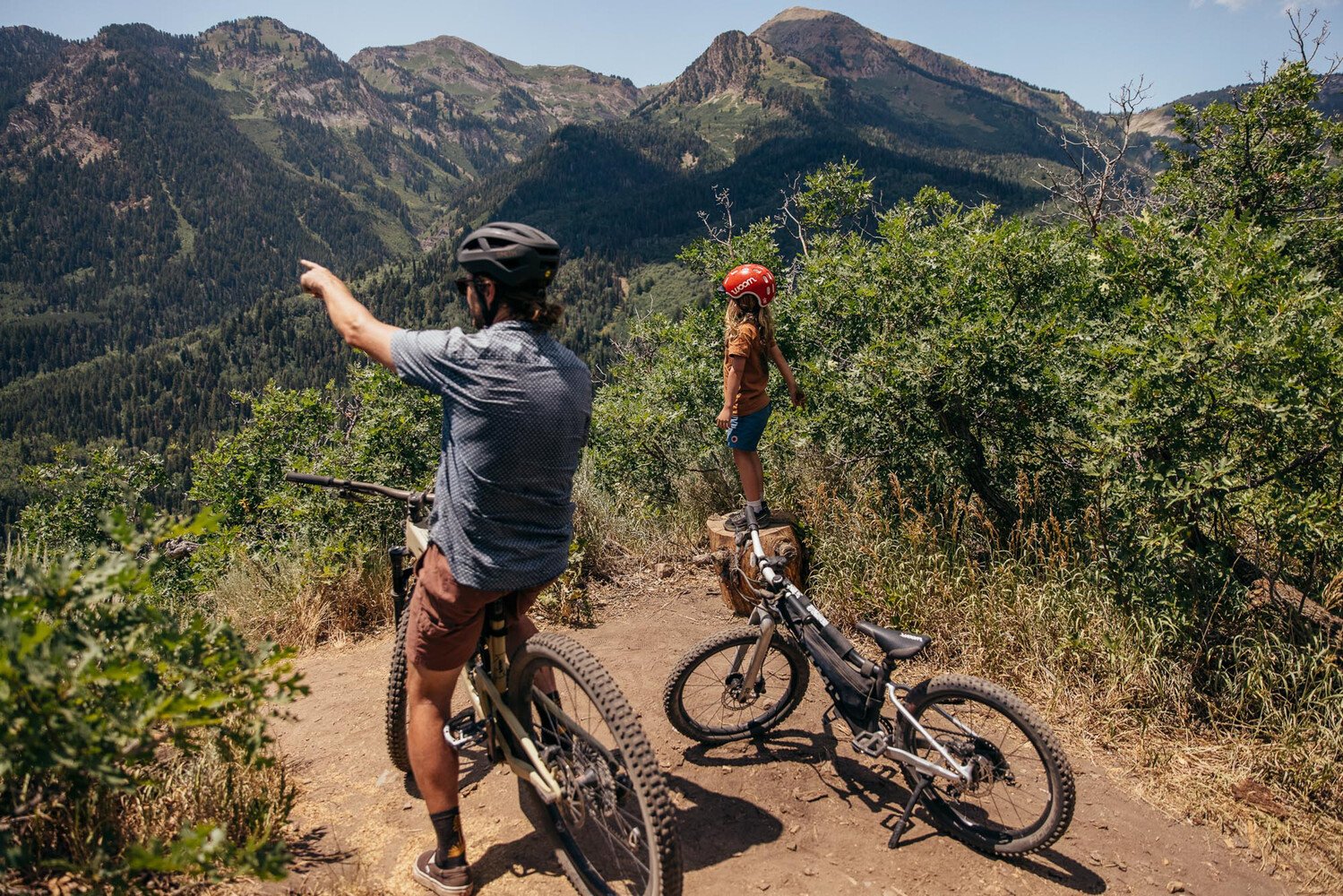
Nothing beats the joy of getting outside with your child, confident in the knowledge that their passion for riding matches yours, right? For mountain bikers, moving through the natural landscape and embarking on adventures creates memories you'll share forever: from your little one's very first ride to that unforgettable picnic in the sun with dramatic mountain scenery, or even the massive grin that spread across their face when they first left you in a cloud of dust.
Children have an innate sense of curiosity. They thrive on time spent in the fresh air when the focus is firmly on fun. Mountain biking satisfies their natural urge to play. It's a form of active play that gets them outside and moving their bodies in the fresh air.
As an added bonus, it also builds up their motor skills and intellectual aptitude, including reaction time, coordination, balance, agility, endurance, creativity, and concentration.
Mountain biking also helps to relieve school-related or social stress. Cutting through the fresh air on two wheels doesn't just have a liberating effect on the mind – it also releases lots of feel-good endorphins. It's not just a summer sport either; cycling is a great mood-boosting activity for winter too. >> For more on the benefits and practicalities of winter riding, check out this article.
Your child also learns how to gauge their ability, sound out their limits and weigh up the risk of what they're about to do. It's entirely likely that your child may fall to the ground once or twice during this process. Here's where it's important to make sure you provide them with the >> relevant equipment to prevent serious injuries. Talking through situations that crop up is also sensible. Could the crash have been avoided? If so, how?
Encouraging kids to push their limits in a safe environment (i.e., with protective gear and appropriate terrain) translates into self-awareness and actually renders them less at risk of harm. Through their experiences, they will gain the ability to assess a situation based on an understanding of their level and the risks involved – a skill that transfers to life outside of riding too.
With each achievement on the bike (however minor), your child's self-confidence gets a boost. It should rightly be a source of pride when they can identify what they have achieved on two wheels. Of course, words of praise from you as their parent or guardian will never go amiss. ;)
And lastly, joint mountain bike adventures strengthen parent-child bonds like little else and bring the family closer together.
It's hard to pinpoint the specific age at which a child might be ready for mountain biking. This depends on their motivation to take up the sport, their motor skills, and their size.
Some five- and even four-year-olds are already fired up to hit the trails. But they're at such an age when it's even more important to take a slow and gentle approach. In fact, it isn't until a child reaches the age of six that their tendons and muscles are sufficiently developed for the strain of such physical exertion.
Until this age, it's best to keep a safe distance from any major climbs, descents, or rough terrain. Try to stick to mellow gravel tracks, access roads, and smooth flow trails. Pump tracks are another decent option, but make sure your child is up to speed with pump track etiquette before doing laps.
As a general rule, mountain bike endeavors can begin as soon as your child is sufficiently enthusiastic and is big enough to ride a bike with 20-inch wheels.
Mountain biking should be fun. And we mean really, really fun. The sort of fun that really demands a suitable mountain bike that weighs as little as possible. A huge, heavy bike would drastically kill the mood.
The weight of a good kids-specific mountain bike should certainly be in single figures, maybe just creeping into double figures if you add a suspension fork. A low weight translates into a lot of fun and will let your little one have a go at jumping every now and again.
For the bike mad among us, the priority needs to be ensuring that your offspring's first encounters with mountain biking are truly enjoyable. And that may mean being flexible and making some sacrifices when it comes to your own ambitions, because from now on…
… the journey is the destination!
You won't get very far, very fast. Mountainous endurance rides at this stage are probably not the way to embed mountain biking in your child's heart. From now on, joint rides may look a little different and take on a vibe that's more akin to visiting an adventure play park, with countless opportunities to explore and play.
To keep kids interested along the route, the idea of paddling in a stream, taking a dip in the lake, skimming stones, settling down in the shade for a picnic, exploring mysterious caves, doing a spot of climbing, or stumbling upon a hidden pond in the woods will add extra excitement and variety. Maybe it'll even be the season for chestnuts or mushrooms if you time it right.
Whatever route you pick, make sure it's nicely varied and always keep their skill level in mind. Plan short rides to begin with and allow enough time to account for any impromptu stops so that the ride can remain nice and relaxed – regardless of any unplanned distractions.
If you're in need of a little inspiration, check out >> our list of fun ride destinations we think you and your child will enjoy.
You're most qualified to assess your child's fitness. Sure, their general level of endurance and power is relevant, but so too is how they feel on the day. What are their energy levels like? On certain days, they'll be flagging before you know it, while on others it seems like they'll never get tired (despite your best efforts to wear them out).
If there's one thing that's clear, it's that we often underestimate children's capacity. Their physiology actually puts them in the ranks of out-and-out endurance athletes. Children use their fat stores for energy, and their count of mitochondria (the powerhouses of our cells) in their muscles outnumbers those of us adults.
So if your six- or seven-year-old child is having a blast on a well-chosen route that captures their attention, it wouldn't be out of the ordinary for them to cover a good 20 to 30 km without even noticing the distance.
Nonetheless, doing such a distance in one fell swoop would be unwise. And short, frequent breaks are better than one or two long ones. Despite a child's aptitude for endurance, they're prone to bursts of energy, preferring to go all out for short periods. As a result, their blood sugar levels drop and their energy levels will need topping up.
Once you notice a triangle of paleness appearing around their mouth and nose, it's high time for a snack stop. This is a clear sign of fatigue.
Even on the shortest rides, the importance of having plenty of food and drink shouldn't be underestimated. If the tank starts to empty, a cereal bar, sliced fruit or a sandwich will work wonders.
The most important factor when picking a new bike is that you select a correctly sized, lightweight kids-specific mountain bike.
Lightweight frames keep the total weight down, as does avoiding suspension for the meantime. For young or particularly light children, the benefits of suspension will be nominal as their body weight simply won't have the desired effect on the technology.
Extra cushioning comes from lightweight, wide tires. Depending on the rider's weight and the ground conditions, these can be ridden with less air pressure for even more comfort. What's more, bumpy terrain can be smoothed out with the right technique – us humans have arms and legs that work as natural suspension.
Once your child tips the scales between 25 and 30 kg, it might be time to consider a suspension fork. However, it needs to be a child-specific model, which means it's suitably lightweight, responsive under minimal load, and adjustable to both the rider's weight and the terrain.
Rear suspension – also known as rear travel or the rear shock – found on full-suspension bikes or fullies adds more weight to bikes. But, unless your child is pinning on a number for races or regularly tackling tough downhill trails, the benefits of rear suspension aren't enough to make it worth diluting the fun factor with the extra weight.
To find out >> how to select the correct size for your child and discover the arguments against buying a bike that's too big for them, check out this article.
Alongside frame size and weight, a bike's geometry and ergonomics are also key elements to consider. The bike should not just be a smaller version of an adult's bike. Instead, it needs scaled-down, child-specific dimensions including size-appropriate stand-over height, seating position, wheelbase, and steering angle.
A low top tube means that your child will be able to react quickly in tricky situations by getting off the bike safely without crashing. If the top tube is too high, there's a risk that your child won't manage to get their leg up and over the bike in a hurry.
For added stability, a low riding position keeps their center of gravity where it should be, while a long wheelbase and flat steering angle amount to a smoother ride. Stability and smoothness are key to increasing your child's confidence and boosting the fun factor.
When it comes to components, the saddle, brakes, grips, brake levers, cranks, stem, shifters, and gear ratio need to be categorically designed for children, i.e., tuned to suit a child's anatomy and physiology.
In concrete terms, child-specific components include brake levers that a child's small hands can comfortably reach, with the option to adjust said reach.
Brakes also need to work effectively without requiring too much effort from your child. There's the risk they'll get tired on long descents otherwise. Disc brakes eradicate this issue and are therefore a sensible choice for kids' mountain bikes.
The grips need to be slim enough for your child to maintain a good grip on them and minimize the risk of their hands slipping off the bars if caught unawares.
When it comes to gears on a children's mountain bike, the best option is a 1x single front chainring set-up with seven to nine gears, covering a wide ratio and equipping for most scenarios. A 2x drivetrain set-up with even more gears would be unwarranted at this age and would probably overwhelm your child, distracting them from what they should really be concentrating on.
Clipless pedals – where your shoes are fixed onto the pedal with cleats – are also an unnecessary feature on kids' mountain bikes.
In the event that your child needs to dismount quickly, flat pedals (also known as platform pedals) will prove much easier. For mountain biking, these sorts of pedals are usually lined with grippy little metal pins to ensure that the soles of the rider's shoes remain firmly on the pedals.
If you're wondering which knobs to turn and bolts to tighten in order to tune each MTB component to suit your child, >> check out this brief guide.
It goes without saying that your kid's mountain bike naturally has to have some style and appeal to their best taste! A pivotal step in the whole process of learning to love mountain biking is therefore to involve them right from the outset in picking out their new bike.
It all comes down to the colors and the overall look of the bike at this point. Our woom OFF and woom OFF AIR mountain bikes – and all our other woom bikes actually – have a timeless design and come in distinctive colors that make a bold statement. Your child can take their pick from a matte black finish with silver components (black) and a special shade of copper with a slight shimmer and black accents (terra coppa).
Defining a list of essential protective gear for your child depends on where they'll be riding and how technical it's going to be.
However, there's really nothing more important than a correctly fitting helmet, such as our >> KIDS' Helmet.
Often overlooked, but equally as fundamental: well-fitting (non-wonky!) kids' riding glasses. Dust, grit, and insects can get into your child's eyes while riding, affecting their vision and distracting them. By reflex, your child might then unwittingly remove a hand from the bars to wipe their affected eye. In the worst-case scenario, they might end up falling off their bike and hurting themselves as a result.
Mountain bikers also need to protect their hands, as they're likely to be the first body part to come into contact with the ground in the event of a crash. A decent pair of long-finger cycling gloves like our >> TENS Bike Gloves will not only provide protection from abrasion, thorns, and splinters, but also improve their grip on the bars.
Specific protectors, also known as soft body armor, have been developed to protect knees, shins, and elbows from injuries.
Comfort is key here: They need to be lightweight, easy to pull on and off, totally unrestrictive, and wholly unlikely to slip while riding. If these boxes are not ticked and your child is unhappy with the fit and comfort of the protectors, it won't take long before they refuse to put them on without an argument.
For kids that are already demonstrating ripper potential at the >> bike park, investing in a neck protector (or a neck brace) as well as a back protector and potentially even crash pants to be worn alongside a comfortable full-face helmet is also a wise move. These will protect their spine, chin, lips, teeth, and nose.
Armed with the right bike and equipment, it's almost time to roll. But it's worth mastering some key off-road skills before heading away from the tarmac. For the best results, don't forget to focus on the fun factor above all else.
We've compiled a few simple, fun exercises for you and your kid to practice together. Find a large, flat, traffic-free area to have a go.
- The Attack Position aka the Gorilla: The ability to ride out of the saddle is key when riding off-road. The Attack Position includes level pedals, one foot in front of the other, weight spread evenly, heels pointing downwards so that the pedals are slightly tilted, and eyes fixed straight ahead.
Encourage your child to practice adopting this position. They can pretend to be a gorilla on their bike as they follow your commands: turn left, turn right, stand taller, bob down. This way they'll be able to determine which foot feels more comfortable in which position.
- The Downhill Position aka the Seal: Even this downhill riding stance can be practiced with a giggle. Demonstrate the seal position on your own bike first and then ask your child to do the same. This involves shifting your body weight as far back over the bike as possible and stretching out your arms to the bars.
The steeper the descent, the further back your bottom needs to be. Play around a little in this position and give your child the chance to discover just how much space for movement they have while on the bike.
- Slow bicycle race: A good sense of balance is vital for mountain biking. A playful way to fine-tune this skill involves staging a slow bicycle race. Who can cover a set distance in the slowest time possible? The last one over the line wins!
You can make it a little tougher by picking a gentle slope – here's where balance meets braking skills. Speaking of braking, your child should only rely on one or two fingers to do the deed, thereby retaining a good grip on the bars at all times.
- It's pick-up time: Picking up various objects while riding is a fun and dynamic way to train your kid's agility and coordination skills. We recommend keeping it simple to start with and gradually making it more difficult.
Why not start by placing a large plastic bottle on top of an upside-down bucket and asking your child to pick it up and put it down again further along the route, or even drop it into a waiting bucket? Make it harder by removing the upside-down bucket and placing the bottle on the floor instead. Then gradually decrease the size of the bottle or use other suitable objects like a tennis ball.
- Riding slalom: To practice off-road cornering skills, use some chalk or cones to outline a slalom course on slightly sloping ground. The aim is to ride the course in the Attack Position, taking care not to cross any of the lines or knock over any of the cones.
Remind your child of the importance of looking ahead in exactly the direction that they want to take. In short, their head will be leading the bike and body in whichever direction it is pointing.
